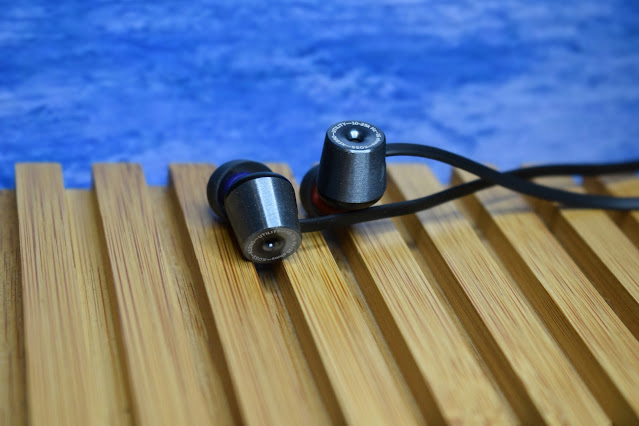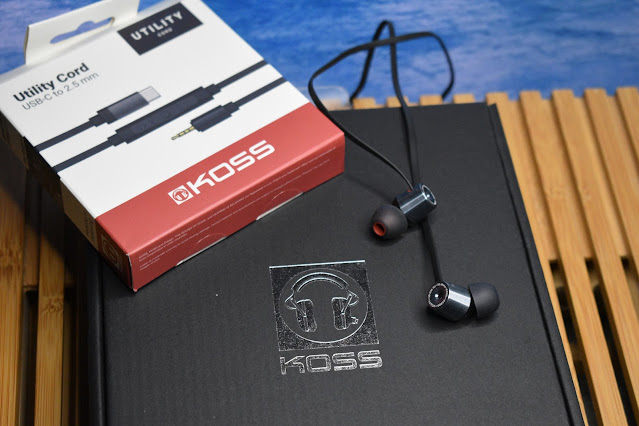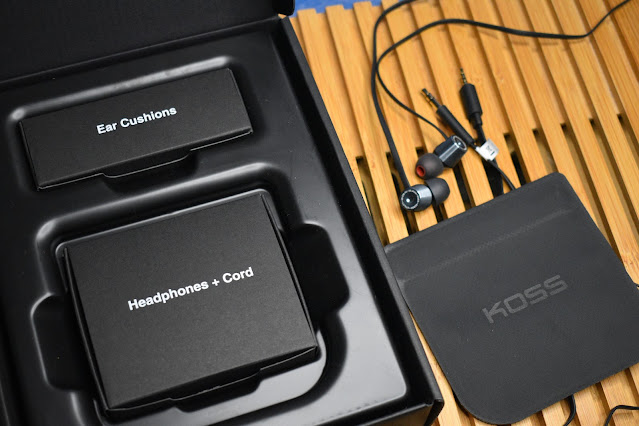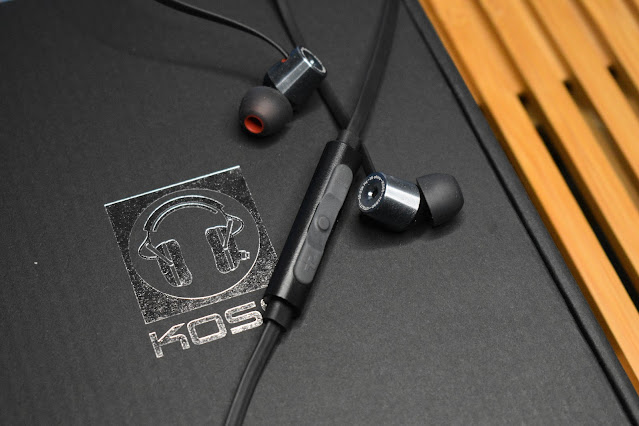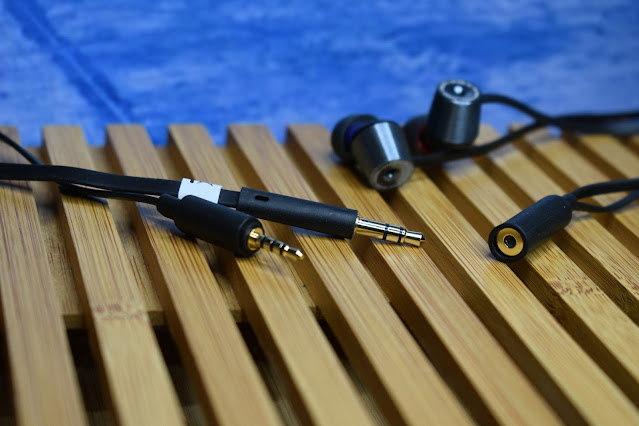- Get link
- X
- Other Apps
English | Español
Also available on YouTube in Spanish: Acho Reviews YouTube
I recently reviewed the Koss KPH40, from the new Utility Series from Koss, and mentioned that they had also sent me the KEB90, a set of IEMs from the same series that also makes use (or can make use) of the Utility Cable.
The same disclaimer that I posted in that review also stands for this one, while Koss have not requested anything at all, not even that I post links, it is good to take into consideration that it has not cost me anything to try out these IEMs.
You can find out more about the KEB90 on the official Koss site here: https://koss.com/collections/utility-series
Intro…
If you haven’t read my review of the KPH40, you can find it here: Koss KPH40 Utility Series. While these are obviously completely different earphones, in the KPH40 review I went into some detail about the series and more specifically the Utility cable in the “Functionality” section.
While I will still mention the Utility cable in this review, I will not go as far into details and include a “Functionality” section in this review, so if you are contemplating the Utility cable, please refer to my previous comments.
As a brief recap, Koss have recently launched the Utility series, which feature two sets of on-ear headphones (the KPH40 that I reviewed and the PortaPro) along with a set of IEMs that I will be focusing on today. One of the main things that stands out about this new series is the use of a detachable cable, allowing you to remove the included 3.5mm TRS cable and swap it for the Utility cable, which includes a DAC/Amp and controls on the cable, terminating in USB-C or Lightning, meaning it can be connected directly to a phone, tablet, laptop, etc.
Although, at the time of creating this review, the KEB90 are not yet available in Europe (in fact, the whole Utility Series will become available in the near here in Europe), Koss did inform me that these IEMs will have a retail price of 89.99€ and the Utility Cable, which is sold separately, will cost 49.99€.
When I reviewed the KPH40, I said that they are up against some tough competition from inside their own brand because, let's face it, there really isn’t anything quite like them. The KPH40, KSC75, PortaPro & KPH30i, are 4 models that I feel compete amongst themselves, all being worthy of consideration and the “best” being dependent only on the subjective tastes of the listener.
In the case of the KEB90, they have a lot more competition. There are so many sub 100€ IEMs on the market, some of which are extremely good, that it would be impossible to name all of them. This means that Koss needs to do something special in order to be in the running, and while Koss is a well known brand name, that isn’t enough to cut it in this IEM world that seems to have multiple new sets released every day.
So, enough with the chit chat and lets get to the real subject, how do the Koss KEB90 perform?
Presentation…
As with the majority of their models, Koss opts for a very simple and basic packaging. Although in this case they are a little more complex than the usual “cardboard only” packaging. They arrive packed in a simple white sleeve that shows the KEB90 on the front with some more basic info and details around the sides and on the back, with a black box that slides out from the inside.
Inside the box we receive the IEMs and the standard 3.5mm cable in a smaller box, a few sets of tips in different sizes of silicone and two sets of foam tips, also in their own small box, along with a Koss branded pouch for transporting them.
The tips I find quite pleasant and are what I have been using throughout this review. A nice little touch is that the cores of the tips are coloured, blue for left and red for right (although they will still work the opposite way 😉 ), which makes the sides instantly recognizable when picking them up.
The storage/transport pouch is rather simple but it works and seems to be quite durable. It’s not quite a case but I am not going to mention other brands that include nothing at 20 times the price.
My opinion of the Koss packaging and presentation is that I like the fact that they usually only use cardboard, packed in a way that keeps them safe for shipping and then can be totally recycled once open. However, in the case of the KEB90, there is a large plastic insert, which, while still being quite simple, does mean I cannot make my usual comment about applauding the use of only cardboard.
Build and aesthetics…
The shape of the IEMs is a little different from usual, as are most things Koss. The metal shell is like a larger version of the Tanya, with an opening on the back that seems like a vent, although covering the vent does not seem to drastically change the sound, which leads me to believe that it is mostly aesthetic, maybe with a small vent inside.
The nozzles are offset and point towards the front, meaning that they are actually quite comfortable once inserted. I still maintain that the flat cable is the best cable that I have tried from Koss, although I prefer it on the KPH40 than on the KEB90. On the IEMs it can be a little microphonic when moving my head around.
The build quality seems to be good and actually inspires me with far more confidence than other Koss models do, but as I said in other reviews, I have never had an issue with Koss, therefore I don’t expect these to have any issues as far as build.
The aesthetics, while not being anything extraordinary, do have a bit of a “Utility” vibe to them, which I actually like. They are not going to win any prizes for beauty but they are certainly not ugly.
Sound…
As with all my reviews, the songs mentioned are clickable links that will allow you to listen to the track mentioned on the streaming service of your choice.
I have tried the KEB90 from my usual setups but to be honest, I find that the Utility Cable works really well with them and that is what I have used for the majority of my listening test. As I mentioned also in the KPH40 review, I can’t spot any difference between the Apple Dongle and the Utility Cable, which I see as a positive because the Apple Dongle is actually a pretty good device (especially if we factor in price). The sound with the Utility Cable is just as good and has the extra benefits of volume control, play/pause and a microphone.
Starting from the bottom of the frequency range, these IEMs have plenty of subbass. In fact, they have a crazy amount of subbass, and mid bass, and lower mids. I think that the KEB90 are actually the IEMs with the most low frequency presence I have heard. The overall signature is very “V” shaped and I must say that the higher frequencies are boosted in a way that actually makes these IEMs listenable, but I will get to the higher frequencies in a moment.
Just to put this into perspective, here is a graph that shows the KEB90, the CCA CRA (which I found to have a large subbass/bass presence) and my preference curve:
As you can see, the low end is almost off the map, being almost 15dB above my personal preference and 10dB above the CRA.
This obviously results in a sound signature that is far bassier than I personally like, but I have to say that I do not hate it. It is not something that I would choose to listen to all the time but it does provide a sound signature that can be very exciting.
There is ample low end rumble for anyone no matter how much of a bass-head they are. This can become overpowering on some tracks that are already boosted in the low frequencies, such as “Bury a Friend” by Billie Eilish, although her voice doesn’t quite disappear as much as I expected it to with the huge wall of bass.
The “Chameleon” test is basically a rumbling massage of the eardrums, with a huge amount of bass, although the higher ranges still manage to break through somehow.
As the whole of the low end is boosted, all the way up to almost 1kHz, there really isn’t much point in trying to divide the frequency ranges, so let’s move straight to the higher mids and their transition into the lower treble.
As you may have noticed on the graph above, the tuning is quite close to that of the CRA, rising to a peak around 5kHz, which is a little higher (in frequency) than the CRA but is also about 5dB more.
I would have expected this to make the sound very harsh and it is actually not the case. Vocals do come across a little recessed, as is to be expected with such a sound signature, but they are nowhere near as absent as I would have imagined. That peak actually balances out the sound signature quite well, although it is still clearly a V shaped profile.
Beth on “Don’t You Worry Child” in not as harsh as she is on many other sets with less boost in these areas, and although she is not as forward as she usually is, she doesn’t get lost too much in the mix.
There are times, such as the break in “Shot Me Down” by David Guetta, where the upper ranges do sound a little too harsh due to those parts of the song not having the wall of bass to smooth things out, but it is really limited to those kinds of occasions. Think of it like when a DJ boost the highs and cuts the bass, it can seem so wrong but as soon as the bass comes back it balances out.
The extension is not great, there is some treble but it is much more focuse on the lower treble (and higher mids) than on the higher treble ranges which roll off fairly quickly when we hit the “Air” regions.
I will say that the soundstage is actually fairly decent, again, much better than I expected from this kind of presentation. Listening to “La Luna (binaural)” by Ottmar Liebert and Luna Negra, there seems to be plenty of space for the instruments to spread out around you.
Detail is not the KEB90’s strong point but it doesn’t sound mushy, which would usually be the case with this amount of bass, and it actually separates things fairly well, all things considered. The bass also seems to be kept clean and fairly precise, something that is quite an achievement with this quantity.
Conclusion…
I’m sorry to say that the KEB90 sound signature is not for me but that doesn’t mean that I haven’t been able to enjoy listening to them. I wouldn’t choose them to listen to the majority of my usual music selection but when I feel like some of “dat bass”, they are a fun listen.
The problem in this case, I feel, is the price point. For 90€ there are a lot of good IEMs out there, such as the Titan S or the Aria. Admittedly the KEB90 aims for a completely different crowd with their tuning, and I can actually see a lot of general consumers listening to these and finding them great, as the bass is certainly not what you expect. In the realms of things like consumer grade JBL, Skullcandy and the other mainstream brands you find in electronics stores, I feel that the KEB90 can easily give them a run for their money.
However, moving back into the audiophile side of IEMs, I think that there are better options for less money. I mean, the CCA CRA is less than 20€ and does similar things in a more balanced way. I am probably not the most ideal person to value these, as I am not one for large amounts of bass (except on occasions when I am in the mood), but I personally wouldn’t rush out to buy a set.
The other side of the coin is that they are very well built and you have the option of using the Utility Cable with them.
In fact, I really feel that “Utility” is a good way of describing the KEB90, they are a rugged set of IEMs that provide a ton of bass that will impress most general consumers even in noisy conditions, they are small enough to always keep in a pocket and I think that they have a market that they will be well received in, I am just not that market.
All FR measurements of IEMs can be viewed and compared on achoreviews.squig.link
All isolation measurements of IEMs can be found on achoreviews.squig.link/isolation
To comment or contact, visit any of the following social media platforms:
